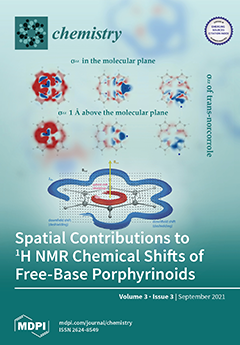The dopamine D
2 agonist MCL-524 is selective for the D
2 receptor in the high-affinity state (D
2high), and, therefore, the PET analogue, [
18F]MCL-524, may facilitate the elucidation of the role of D
2high in disorders such
[...] Read more.
The dopamine D
2 agonist MCL-524 is selective for the D
2 receptor in the high-affinity state (D
2high), and, therefore, the PET analogue, [
18F]MCL-524, may facilitate the elucidation of the role of D
2high in disorders such as schizophrenia. However, the previously reported synthesis of [
18F]MCL-524 proved difficult to replicate and was lacking experimental details. We therefore developed a new synthesis of [
18F]MCL-524 using a “non-anhydrous, minimally basic” (NAMB) approach. In this method, [
18F]F
− is eluted from a small (10–12 mg) trap-and-release column with tetraethylammonium tosylate (2.37 mg) in 7:3 MeCN:H
2O (0.1 mL), rather than the basic carbonate or bicarbonate solution that is most often used for [
18F]F
− recovery. The tosylated precursor (1 mg) in 0.9 mL anhydrous acetonitrile was added directly to the eluate, without azeotropic drying, and the solution was heated (150 °C/15 min). The catechol was then deprotected with the Lewis acid In(OTf)
3 (10 equiv.; 150 °C/20 min). In contrast to deprotection with protic acids, Lewis-acid-based deprotection facilitated the efficient removal of byproducts by HPLC and eliminated the need for SPE extraction prior to HPLC purification. Using the NAMB approach, [
18F]MCL-524 was obtained in 5–9% RCY (decay-corrected,
n = 3), confirming the utility of this improved method for the multistep synthesis of [
18F]MCL-524 and suggesting that it may applicable to the synthesis of other
18F-labeled radiotracers.
Full article





